Today, at the occasion of the World Soil Day 2016, the Food and Agriculture Organisation (FAO) of the UN has published nine maps listing out the soil problems. The campaign aims to connect people with soils and raise awareness on their critical importance in our lives.
1Soil acidification
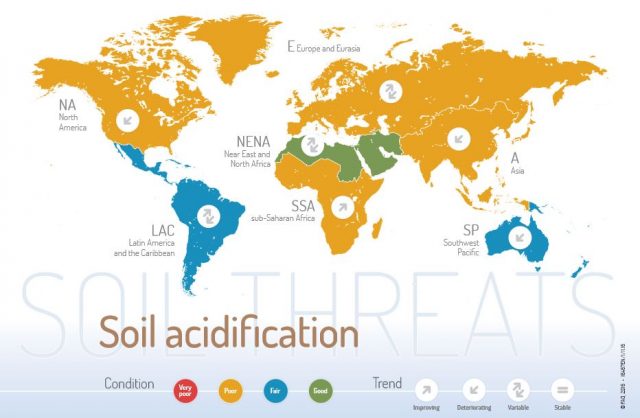
The map explains soil acidification is a process of lowering of the soil pH caused by the buildup of H+ and Al3+ ions in the soil and the leaching of base cations such as Ca2+, Mg2+, K+ and Na+.
The map further explains the major causes of soil acidification: that are long term rainfall, draining of potentially acid sulphate soils, acid deposition, excessive application of ammonium-based fertilizers, deforestation, and land use practices that remove all harvested materials.
Soil acidification can be improved by incorporating the use of lime to improve soil pH. It preserves soil properties and buffer soil acidity.
2Soil biodiversity loss

It is a wide known fact that approximately a quarter of our planet’s biodiversity exists in the soils. Hence, the decline in the diversity of organisms present in the soil affects multiple ecosystem fuctions, including plant diversity, decomposition, nutrient retention and cycling, plant and animal health, soil carbon sequestration and greenhouse gas emissions. Therefore, preserving soil biodiversity is important for enhancing the soil health.
3Soil compaction
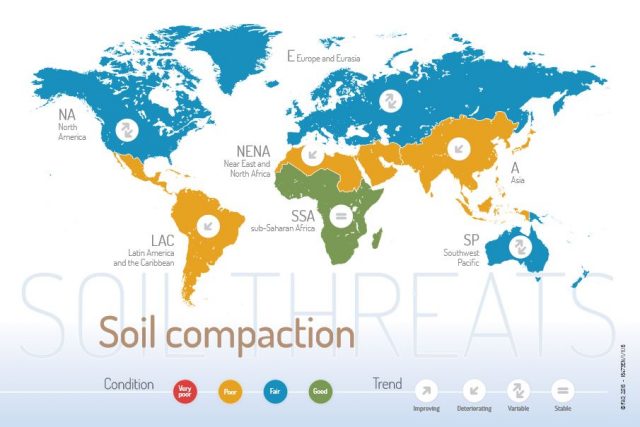
Soil compaction is the process of increase in soil density and a decline of macro-porosity that impairs soil functions and impedes root pentration and water and gas exchange. Soil compaction can reduce crop yields by as much as 60%. Agricultural mismanagement 80% and overgrazing 16% are the two major causative factors of human induced soil compaction.
Minimum-tillage agriculture is among the top options to reduce tillage costs, conserve soil and water, increase soil organic carbon pools and reduce net CO2 emissions.
4Soil contamination

The increase of toxic compounds (heavy metals, pesticide, etc.) in soils affect human health and damage the soil ecosystem. The three major pathways for diffuse soil contamination are atmospheric deposition agriculture and flood events. Soil contamination can reduce food security by decreasing crop yields and rendering crops unsafe for consumption.
5Soil salinization and sodification
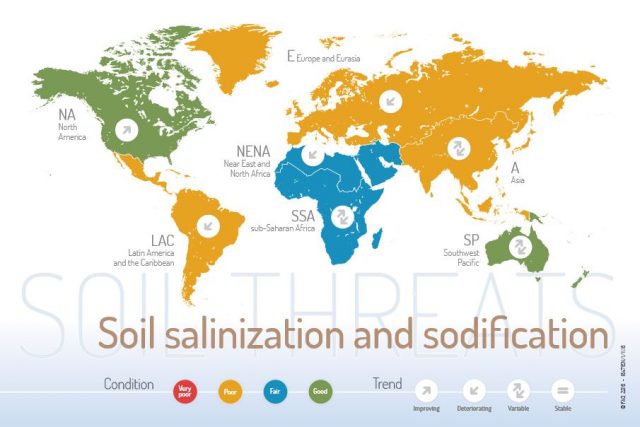
Soil salinization and sodification increases water-soluble salts in soil, including potassium, magnesium, calcium, chlorine, sulphate, carbonate, bicarbonate (salinization) or high sodium content (sodification). It negatively affects plant growth, reduces crop yields and can make soils unproductive.
Soil salinity threat can be contained by direct leaching of salts, planting salt tolerant varieties, phytoremediation, chemical amelioration and/or use of organic amendments
6Soil nutrient imbalance
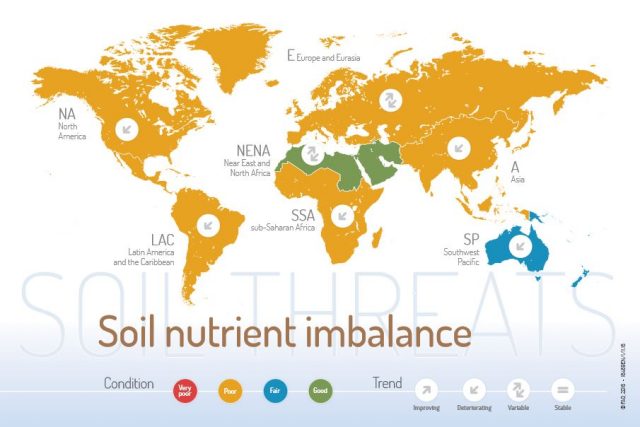
Incorrect land use and management may result in an excess of nutrient causing soil contamination and contributing to water quality deterioration and greenhouse gas emissions. Conversely, a lack of nutrients may lead to low soil fertility.
Increasing soil organic matter can boost soil fertility and balance the soil nutrient system
Improvements in nutrient-use efficiency in the use of agricultural inputs, providing direct benefit to the environment and increasing food production.
7Soil sealing
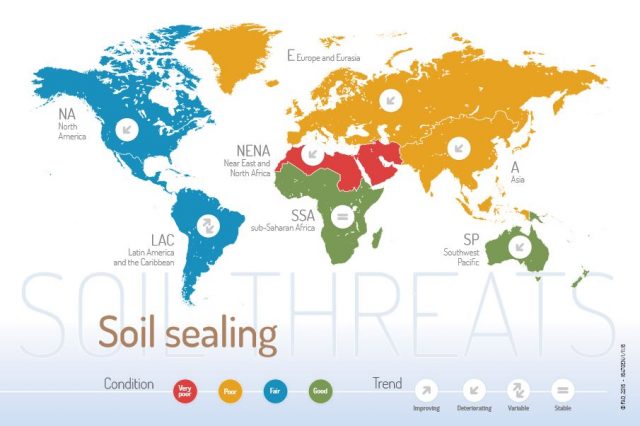
Permanent covering of the soil surface with impermeable artificial materials, leading to non-reversible loss of soil and most of its ecosystem services.
The main negative impacts on ecosystem services include losses of food and fibre production; significant decreases or total loss of the soil’s water retention; reduced neutralization and purification capacities and reduction of carbon sequestration capacity.
According to a record, worldwide, 17 hectare of soil are sealed every minute under expanding infrastructure
8Soil organic carbon loss
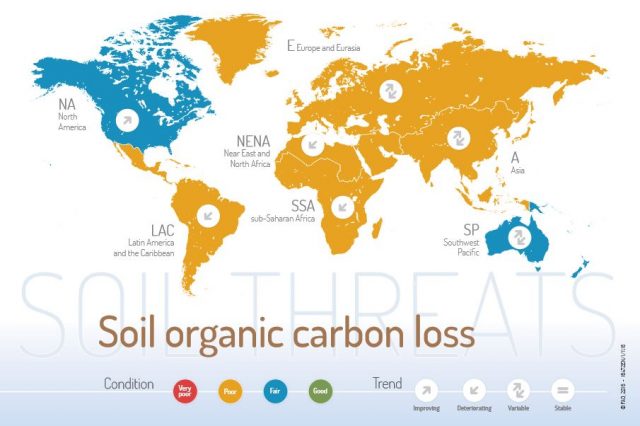
Decline of organic carbon stock in the soil affects its fertility status and climate change regulation capacity.
Approximately 1,417 billion tonnes of SOC are stored in the first meter of soil and about 2500 billion tonnes at two meters soil depth. The global loss of the SOC pool since 1850 is estimated at about 66 billion tonnes, mainly caused by land use change.
There is more organic carbon in the soil than there is in the vegetation and atmosphere combined
Sustainable soil management fosters CO2 sequestration, boosts soil health and contributes to achieving the SDGs, especially climate change adaptation and mitigation.
9Soil erosion
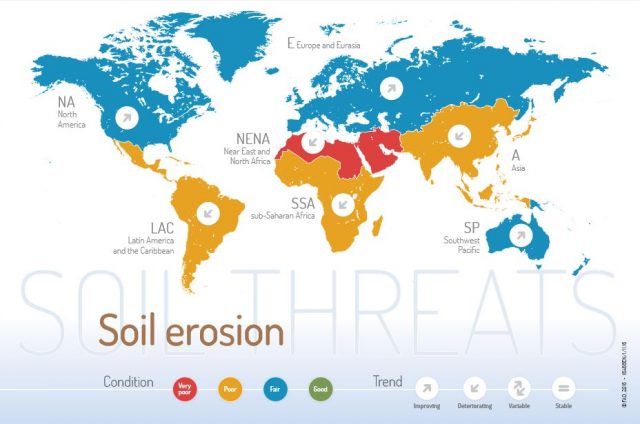
Accelerated removal of topsoil from the land surface through water, wind, or tillage.
Each year, 20 to 3o Gt (billion tonnes) of soil is estimated to be eroded by water, 5 Gt by tillage and 2Gt by wind on arable land. If the current trend of soil erosion remains unchanged the total annual production potential is projected to be reduced by 1o% by 2050.
Average rate of soil erosion by wind, water and tillage is estimated at 0.9mm per year.
Erosion rates can be reduced through the application of appropriate management techniques and structural measures such as terrace and waterway construction.




